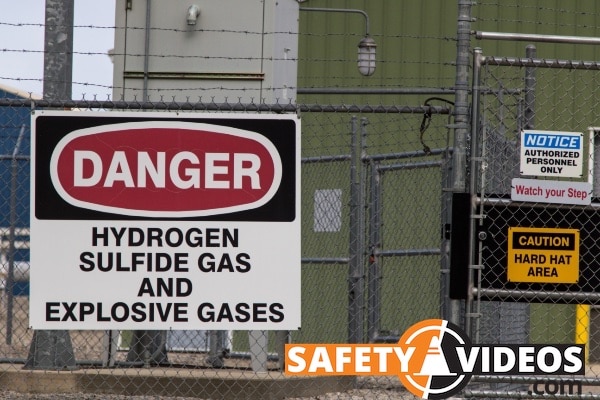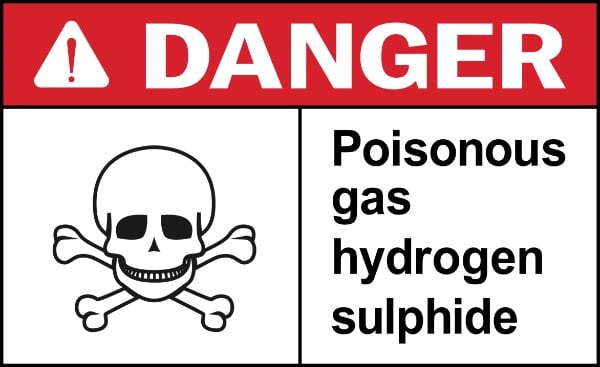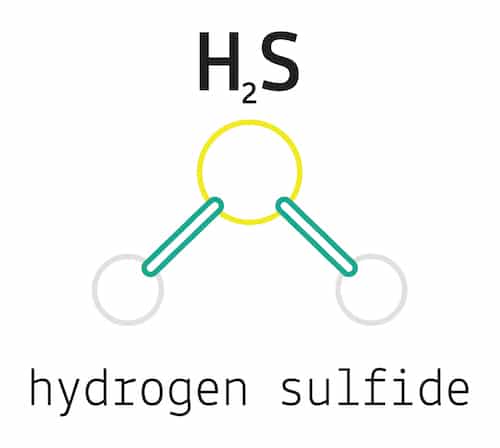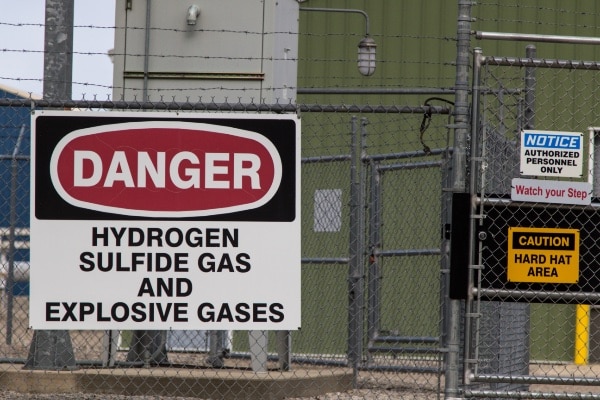13+ Best H2S Safety Tips for 2023 – [Hydrogen Sulfide]

Hydrogen sulfide (H2S) gas is a dangerous compound that can be found in a variety of job sites. Developing administrative controls helps create safe workplaces and reduce the risk of exposure to keep employees safe.
Below we provide tips on identifying hydrogen sulfide, OSHA’s for keeping workers safe, how to control exposure, and what to do if someone is exposed to it for too long. The H2S Safety Tips that you will find below, along with good quality h2s training, can save your life of that of a co-worker.
What Is Hydrogen Sulfide Gas?
Hydrogen sulfide is a corrosive, poisonous, and flammable gas found in nature and as a product of various industrial processes or manufacturing processes. It’s a colourless gas and known for smelling like rotten eggs. It’s also known as H2S gas, rotten egg gas, sewer gas, and sour gas. H2S gas irritates the mucous membranes in the respiratory tract and other parts of the body. It can cause great harm or death to an individual exposed to the gas.
Hydrogen sulfide occurs naturally in natural gas and crude petroleum. This gas can be produced when organic matter such as human and animal waste breaks down. Some examples include when organic materials decay or the human body digests food. If you are looking for a full article on what is h2s we have a comprehensive write up on our site.

Hazards of Hydrogen Sulfide
- Since hydrogen sulphide is heavy, it remains in low-lying areas.
- It’s an extremely hazardous gas that is flammable and toxic.
- It has the odor of a rotten egg even at a low concentration.
- The sense of smell is affected, temporarily destroying it.
- H2S is colorless, so there are no visible signs it is present.
H2S gas enters through the lungs, blocking oxygen transfer to the blood, causing potentially fatal paralysis of the respiratory system. This is why respiratory protection is essential when working in areas with H2S.
Hydrogen Sulfide Exposure
Although the gas smells rotten at low concentrations, your sense of smell can be affected with higher concentrations and should not be relied on.
How Exposure Affects Health
Hydrogen sulfide is a chemical asphyxiant. It interferes with oxygen utilization and central nervous system processes (CNS). In low concentrations, it irritates the eyes, nose, and throat. At moderate concentrations, it causes dizziness, nausea, and vomiting. High concentrations can cause a sudden loss of consciousness, coma, and even death. Only a few breaths are necessary to induce these symptoms.
ATSDR Guidance
According to the Agency for Toxic Substances and Disease Registry (ATSDR), workers in some industries can be exposed to high concentrations of hydrogen sulfide compared to the general population. Workers at a higher risk of exposure tend to work in these industries:
- Mining
- Pulp and paper mills
- Petroleum and natural gas drilling
- Sewage treatment plants
- Wastewater treatment
Workers who have no choice but to work in high-risk areas or a confined space are required to wear respiratory protection. Anyone who experiences unusual side effects or symptoms within 24 hours of exposure should immediately call a doctor or visit an emergency room.

How Can You Protect Yourself From H2S? Tips to Recognize Its Presence
One of the first signs of this gas is a rotten egg smell. You may not know that you are exposed to hydrogen sulfide because it’s a colorless gas, but you will smell it when you first come in contact with it. This is one of the most popular H2S safety tips – learn to watch out for the odor of this foul smelling gas.
Hydrogen sulfide gas is considered immediately dangerous to life because of its properties. Some health issues that can occur when you come in contact with it include:
- Difficulty breathing
- Dizziness
- Headaches
- Death
- Severe eye irritation
- Severe respiratory effects
Individuals with asthma or other conditions affecting their respiratory system are at a greater risk of harm or death even at less harmful levels of H2S.
What is H2S Safety? Brief Tips & Best Practice
- Adhering to all company guidelines and health policies.
- Having a qualified person use testing equipment.
- Using gas monitors and test equipment for gas testing before starting a job.
- Having monitors calibrated regularly to ensure proper function.
- Considering and planning hazards before working.
- Awareness and training courses for all employees.
- Emergency evacuation drills.
- Staying aware of wind direction.
- Working in pairs.
- Responding immediately to emergency alarms or signals.
- Following the safety line in an emergency.
- Understanding the threshold limit value.
- Understanding the time-weighted average.

What is the OSHA Standard for H2S? Tips to Remain OSHA-Compliant
The OSHA standard for hydrogen sulfide addresses specific standards for maritime workers, the construction industry, and other sectors.
Exposure Limit
The guidance highlights that exposure must not exceed 20 parts per million (PPM) with only one exception: that no other amount of exposure occurs during an 8-hour work shift. In this case, exposure can exceed 20 PPM but no more than 50 PPM, the peak amount at a single time beyond 10 minutes.
OSHA Guidelines
- The permissible exposure limit (PEL) is 20 PPM.
- The general industry peak is 50 PPM for up to 10 minutes if no other exposure is made during a standard 8-hour shift.
- The construction 8-hour limit is 10 PPM.
- The shipyard 8-hour limit is 10 PPM.
These are the general OSHA guidelines, but there can be some variance depending on the industry and the job. Make sure to follow all guidelines and safety precautions per the job code.
Safety Tips for Controlling Exposure
Implement Ventilation & Engineering Controls
Hydrogen sulfide engineering controls are a way for OSHA to ensure the proper safety measures are taken when it comes to protecting employees who work in a confined space.
- Natural Ventilation: This comes with normal airflow where windsocks and streamers are blowing.
- Mechanical Ventilation: For confined spaces where fans and blowers are the only ventilation systems that can be used.
Exhaust and ventilation systems should be used to reduce levels of gas. Make sure that the system is considered separate from any other ventilation system that is explosion-proof.
When employees work in confined spaces or poorly ventilated areas like basements, manholes, sewer lines, and underground vaults, measures should be in place. Ventilation should be continuously working and in compliance with OSHA standards to avoid working in high concentrations of HS2 gas.
Use Personal Protective Equipment
Personal protective equipment (PPE) will protect workers from hydrogen sulfide exposure. The Occupational Safety and Health Administration (OSHA) regulates and enforces H2S gas exposure limits to protect companies and their employees.
If testing shows that there is H2S gas in the vicinity and exposure is not preventable, using the right respiratory protection and other PPE is essential.
A self-contained breathing apparatus (SCBA) is one helpful PPE in this environment. A self-contained breathing apparatus, also known as a compressed air breathing apparatus, is worn to provide breathable air in a situation that is immediately dangerous to life. Firefighters commonly wear this device.
A self-contained breathing apparatus and communication equipment are required in the event of a rescue. An individual who has been exposed to a high amount of H2S gas should not be rescued without wearing the proper self-contained breathing apparatus and the appropriate training for rescue.

Safety Tips for When Someone Has Been Exposed
Since the ability to distinguish a smell is gone after prolonged exposure, it’s vital to get away from an area with concentrated gas immediately.
For Symptoms of Exposure
If an individual shows signs or symptoms of exposure, they should be immediately moved somewhere with fresh air. If breathing is difficult, they should be given an air purifying respirator to help them combat the onset respiratory effects from gas inhalation.
If Breathing Has Stopped
If their breathing has stopped, trained personnel should provide them with artificial respiration (AR) and begin cardiopulmonary respiration (CPR) or use automated external defibrillation (AED). Mouth-to-mouth should be avoided unless mouth guards or shields are used to prevent exposure.
Can H2S Explode When Mixed With Air?
Since H2S gas is highly flammable, it can be explosive when mixed with certain substances or other compounds. Although it won’t explode when it comes in contact with air alone, if mixed with air, the combination can become explosive in the presence of an ignition source.
When hydrogen sulfide is burned, toxic gases and vapors are released. Even low concentrations are enough to cause an explosion. It’s possible that it can travel back to the ignition source and flash back. If H2S gas is ignited, it can produce sulfur dioxide, another toxic gas. If a H2S gas source ignites, a water spray should be used to put it out. A dry chemical foam and carbon dioxide can also be used to extinguish a flame.
Staying Safe Against Hydrogen Sulfide Gas
When it comes to being safe working in environments where hydrogen sulfide is present, following company safety policies and OSHA guidelines can make the difference between life or death. Employees must receive training if they are at risk of being exposed to hydrogen sulfide.
The short-term exposure limit should be strictly followed to keep employees safe. Relying on your sense of smell to detect the gas will result in injury or fatal consequences. Always be vigilant and pay attention to equipment readings that can inform you if the area is safe to work in or not and for how long. You don’t want to make a mistake that could cost you or someone else their life. Follow these H2S safety tips to keep you, your crew, and your co-workers safe while they work.